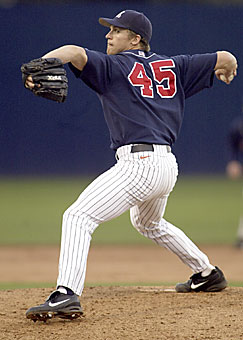 |
|
KEVIN B. KLAUS/Arizona Daily Wildcat
|
Kevin Guyette delivers a pitch earlier this season at Sancet Stadium. Guyette is one of several Wildcats who may forego his senior season to play in the major league.
|
|
|
By Michael Schwartz
Arizona Daily Wildcat
Thursday, April 28, 2005
Print this
The words "student" and "athlete" never used to belong in the same sentence.
The recently released Academic Progress Rate looks to make the "student" part as important as the "athlete" part in college athletics.
The APR is meant to improve educational standards by requiring a minimum number of athletes per team to graduate and stay academically eligible.
Each athlete earns two points: one for remaining at the school on pace to graduate and another for staying academically eligible and ultimately graduating.
Teams must hit an APR of 925, which correlates to 92.5 percent of the possible points and about a 50 percent graduation rate.
Harsh penalties exist for programs that record substandard APR scores.
Deficient teams will be unable to replace scholarship players who leave or are academically ineligible for as long as they were meant to stay around.
By 2008-09, chronically failing teams may be shut out of the postseason, a result that changes the landscape of NCAA sports.
While results are only preliminary this year and no sanctions will be imposed until next season, a Pacific 10 Conference-high five Arizona programs recorded failing scores: baseball, football, men's
 |
|
Michael Schwartz
Staff Writer
|
|
|
outdoor track, women's indoor track and women's outdoor track.
The Wildcats averaged a conference-low 916, as baseball scored lowest with a pathetic score of only 855.
This can be largely attributed to the nature of the sport.
The way the major league baseball draft is set up, players can either enter the draft out of high school or after their third collegiate season.
This means that loads of junior players routinely leave college a year early to enter professional baseball.
"It's going to be a challenge for us because it doesn't matter what anybody says, when you're a junior and you get a chance to go sign, you're going to sign," baseball head coach Andy Lopez said. "That's college baseball, so it will affect us. It's just going to make us alter some of the things that we do in terms of our initial recruiting."
The new system leaves Lopez's baseball team little margin for error. After cracking the top 10 and staying there for the majority of the season, the No. 9 Wildcats have finally returned to national prominence.
However, the same players that have led this resurgence could lead to its demise.
Juniors left fielder Trevor Crowe, catcher Nick Hundley, pitcher John Meloan, first baseman Jordan Brown and pitcher Kevin Guyette will likely all leave, while junior center fielder Chris Frey is a possibility as well.
Regardless of their academic standing, they will all count against the squad's APR.
"It won't destroy us, but it will definitely put a dent," Lopez said. "If they all leave academically eligible, academically sound, we'll be in good shape, but if just one or two of them don't, we've got some issues."
With all the demands on a student athlete, the state of a program cannot be dependent on one student bombing a class, possibly in a semester in which his first concern is baseball. With a NCAA average of 11.7 scholarships per team to be doled out, the baseball team cannot afford to lose any.
Lopez said he agrees with the APR but also acknowledged that student-athletes often have the ear of an adviser talking about a million-dollar signing bonus after the season. A student-athlete may not have the incentive to raise that algebra grade knowing they have a big pay day coming up anyway.
"I've been doing it for 23 years, and we agree with the rule 1,000 percent, but I know after 23 years there's a lot of outside influences that have a way of dissuading sound wisdom," he said. "Sound wisdom is they should be eligible, and I agree with it. They should get their degree. I agree with that, but I can't control the outside influences."
On its face, the APR could be the best thing to happen to college sports, as many athletes must remember they are students and that graduation is also for them.
However, a program such as Arizona baseball should not be punished for signing top athletes who produce on the field but will leave after three seasons. This will cause schools to recruit athletes that may not be as talented and so more likely not to get drafted and stay all four years.
The APR should differentiate between students who are academically ineligible and not on pace to graduate from those who are earning quality grades but leave for the professional ranks by the rules.
By subtracting only one-half point instead of a whole point, programs would not be severely punished by recruiting star athletes.
Otherwise, college sports will never be the same.
Michael Schwartz is a journalism freshman. He can be reached at sports@wildcat.arizona.edu.
